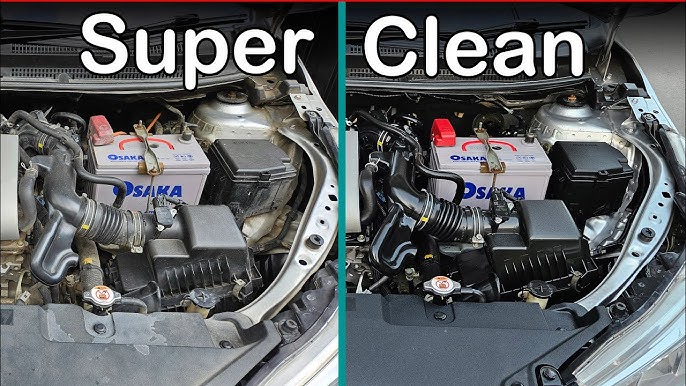Keeping your car engine clean is important. A clean engine runs cooler. It helps you find leaks fast. Also, it looks nice if you open the hood. Washing your engine is simple. But you must do it carefully. This guide will help you wash your car engine step by step.
Why Wash a Car Engine?
Engines get dirty from dust, oil, and dirt. Over time, this dirt builds up. It can cause problems. Dirt can hide leaks or damage. Cleaning helps you see the engine better. It can stop parts from getting too hot. It also helps your car last longer.
What You Need to Wash Your Engine
Before you start, gather these items:
- Protective gloves
- Plastic bags and tape
- Soft brush or paintbrush
- Engine degreaser or mild detergent
- Garden hose with spray nozzle
- Old towels or rags
- Air blower or compressed air (optional)
Safety First
Always wash your engine when it is cool. A hot engine can cause burns. Also, water on a hot engine may cause damage. Make sure your car is parked in a safe place. Avoid washing the engine on very sunny days. This stops quick drying and spots.
Step 1: Prepare the Engine
Start by opening the hood. Look for parts that should not get wet. Cover these parts with plastic bags. Use tape to keep bags in place. Common parts to cover are:
- Air intake
- Battery terminals
- Distributor and spark plug wires
- Any exposed electrical parts
This protects sensitive parts from water damage.
Step 2: Remove Loose Dirt
Use a soft brush to remove dust and dirt. Brush gently around the engine. Do not press too hard. You can also use a paintbrush for small spaces. This step makes washing easier and better.
Step 3: Apply Engine Degreaser
Spray the degreaser on dirty parts. Avoid spraying on covered parts. Let the degreaser sit for 5 to 10 minutes. It breaks down grease and oil. Do not let it dry completely. If it dries, it will be harder to clean.

Credit: www.youtube.com
Step 4: Scrub the Engine
Use a soft brush to scrub the engine. Focus on areas with heavy grease. Be careful not to damage wires or hoses. Scrubbing helps remove stuck dirt. Take your time and be gentle.
Step 5: Rinse the Engine
Use a garden hose with low pressure. High pressure can damage parts. Slowly rinse the engine to wash away the degreaser. Avoid spraying directly on covered parts. Rinse until all soap and dirt are gone.
Step 6: Dry the Engine
After rinsing, dry the engine with old towels. Wipe as much water as you can. If you have an air blower, use it to dry small spaces. This helps stop rust and electrical problems. Let the engine air dry for at least an hour.
Step 7: Remove Plastic Covers
Take off the plastic bags from the engine parts. Check if these parts are dry. If not, dry them carefully with a rag. Make sure no water is left near electrical parts.
Step 8: Check the Engine
Start the engine and let it run for a few minutes. This helps dry any hidden water. Watch for any strange sounds or smells. If everything is normal, your engine is clean and ready.
Tips for Washing Your Car Engine
- Always wash the engine in a shady place.
- Do not use harsh chemicals or strong brushes.
- Be gentle with wires and hoses.
- Cover all electrical parts well.
- Wash your engine every few months.
- Check your owner’s manual for special instructions.

Credit: www.youtube.com
Common Mistakes to Avoid
Many people make errors when washing their engines. Here are some common mistakes:
- Washing a hot engine
- Using high-pressure water
- Not covering electrical parts
- Using too much degreaser
- Not drying the engine well
Avoid these mistakes to keep your engine safe.
Benefits of a Clean Engine
Washing your engine has many benefits:
| Benefit | Description |
|---|---|
| Better Cooling | Removes dirt that traps heat around the engine. |
| Find Leaks Early | Clean engine shows oil or fluid leaks easily. |
| Longer Engine Life | Less dirt means less wear and tear on parts. |
| Improved Appearance | Engine looks neat and well-maintained. |
When to Wash Your Engine
You don’t need to wash your engine often. Here are good times to clean it:
- After driving on muddy roads
- When you see lots of oil or dirt
- Before selling your car
- When doing a full car cleaning
Frequently Asked Questions
Can I Wash My Car Engine With A Garden Hose?
Yes, but use low pressure to avoid damaging electrical parts or connectors.
How Often Should I Clean My Car Engine?
Cleaning every 6 months keeps the engine free from dirt and grease build-up.
Is It Safe To Use Soap On A Car Engine?
Use a mild, engine-safe degreaser instead of regular soap for best results.
Should I Cover Engine Parts Before Washing?
Cover sensitive parts like the battery, air intake, and alternator to protect them.
Conclusion
Washing your car engine is easy and helpful. It keeps your car healthy and looking good. Always be careful and use the right tools. Follow the steps and tips in this guide. Clean your engine safely and enjoy a better car experience.


